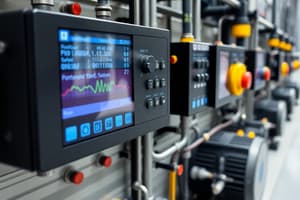Podcast
Questions and Answers
What is the primary objective of automatic control in control theory?
What is the primary objective of automatic control in control theory?
To manipulate a process over time to perform in a desired manner.
Explain the significance of a feedback loop in control systems.
Explain the significance of a feedback loop in control systems.
A feedback loop quantifies the difference between desired and actual outcomes and adjusts the process accordingly.
What role do process variables play in automatic control?
What role do process variables play in automatic control?
Process variables are measured to assess the performance of the system against desired outcomes.
Define optimality criteria in the context of control systems.
Define optimality criteria in the context of control systems.
Describe the concept of a PID controller.
Describe the concept of a PID controller.
How does measurement error affect control systems?
How does measurement error affect control systems?
Why might a control system need to adapt to disturbances?
Why might a control system need to adapt to disturbances?
What is an example of a real-world application of control theory?
What is an example of a real-world application of control theory?
What role do actuators and sensors play in a control system?
What role do actuators and sensors play in a control system?
How do disturbances affect the functioning of control systems?
How do disturbances affect the functioning of control systems?
Explain the importance of filters in a control system.
Explain the importance of filters in a control system.
What is the function of the system clock in control systems?
What is the function of the system clock in control systems?
How does feedforward control influence transient behavior in a control system?
How does feedforward control influence transient behavior in a control system?
What is the role of actuators in a control system?
What is the role of actuators in a control system?
In the context of control theory, what is the significance of sensors?
In the context of control theory, what is the significance of sensors?
How does feedforward control differ from feedback control?
How does feedforward control differ from feedback control?
What does the term 'process' refer to in a control system?
What does the term 'process' refer to in a control system?
Why is it important for military planes to have a robust control loop?
Why is it important for military planes to have a robust control loop?
What does the term 'optimality criteria' imply in the context of control systems?
What does the term 'optimality criteria' imply in the context of control systems?
What is the impact of measurement error in a control loop?
What is the impact of measurement error in a control loop?
Explain how a digital/analog (D/A) converter functions in a control system.
Explain how a digital/analog (D/A) converter functions in a control system.
Study Notes
Automatic Control Systems
- Automatic control aims to manipulate a process over time to achieve desired performance.
- Key Components:
- Process Variables: Measured to quantify the difference between desired and actual behavior.
- Control Loop: Utilizes feedback mechanisms to adjust external manipulable variables based on measured differences.
- Controller: Processes the difference between measured and reference values.
- Actuators: Implement the control decisions by manipulating the system.
- Sensors: Gather data about the process variables.
- Optimality Criteria: Can be defined based on goals such as minimizing energy and resources, optimizing process dynamics, or achieving a desired result within a specific timeframe.
- Control Signals:
- Feedback: Based on the measured difference between desired and actual values.
- Feedforward: Designed to anticipate and compensate for disturbances before they affect the system.
- Disturbances: External factors that can affect system performance, such as environmental changes or noise.
- Measurement Errors: Inaccuracy in the data measured by sensors, such as noise.
- Implementation: Controllers can be implemented using various methods, including analog, digital, or a combination of both.
- Applications: Automatic control principles are used in various fields, including engineering, natural sciences, medicine, and non-technical domains.
- Example: The control system in an airplane, where controllers manage stability and performance based on real-time data.
Control Loop Components
- Controller:
- Filters: Eliminate unwanted noise from the measured signals.
- Analog/Digital (A/D) Converters: Translate analog signals into digital format for processing.
- Digital/Analog (D/A) Converters: Translate digital control signals into analog form for actuators.
- Process Dynamics:
- Represents the behavior of the system, including actuators, the system itself, and sensors.
Other Considerations
- Transient Behavior: The system’s response to changes in its environment or input.
- System Clock: Used to synchronize the components within the control loop for proper timing.
- Large-Scale Systems: Involve complex systems with many interconnected subsystems.
- Military Applications: Automatic control plays a vital role in military aircraft and systems for enhancing performance and stability.
- Example: The control system of a military airplane, where controllers enhance stability and maneuverability, even in challenging conditions.
Studying That Suits You
Use AI to generate personalized quizzes and flashcards to suit your learning preferences.
Related Documents
Description
This quiz covers the fundamental concepts of automatic control systems, including key components such as sensors, actuators, and controllers. Explore how these components interact to manipulate processes over time, aiming to achieve optimal performance. Test your understanding of control loops, feedback mechanisms, and optimality criteria.



